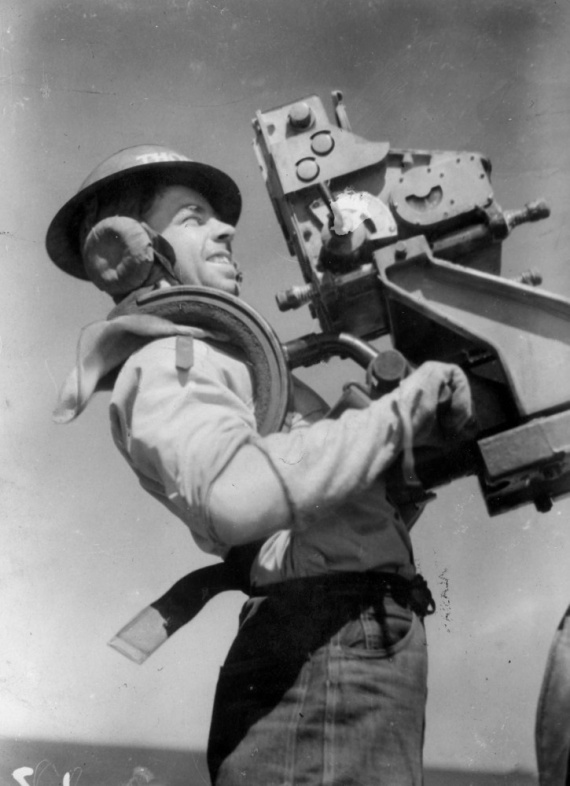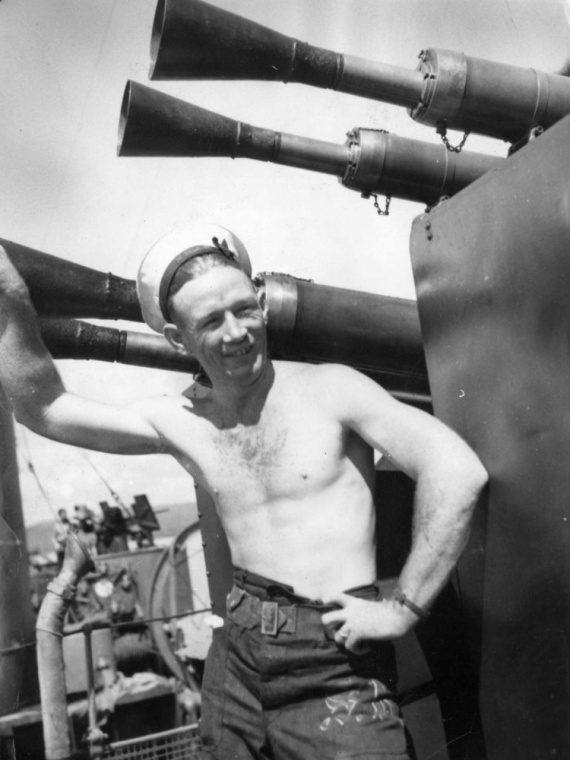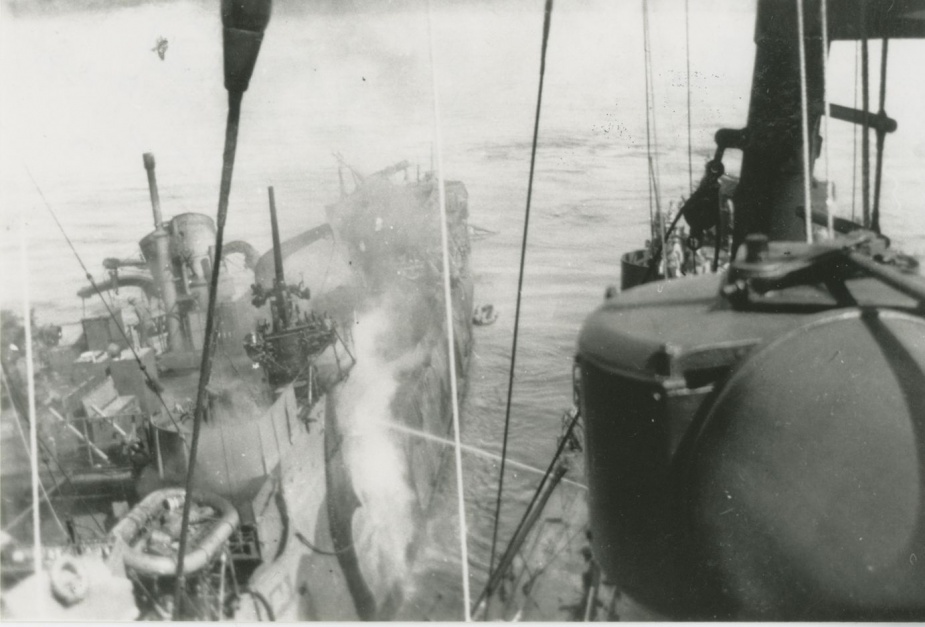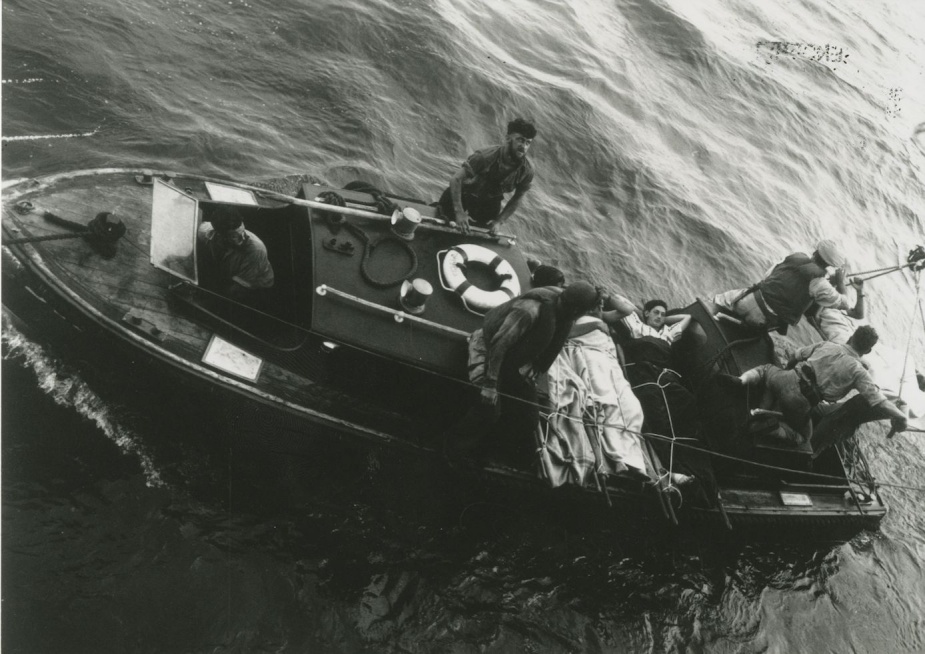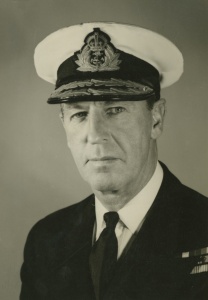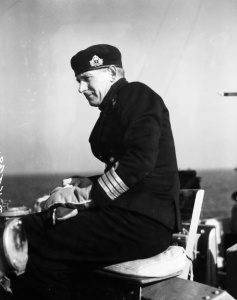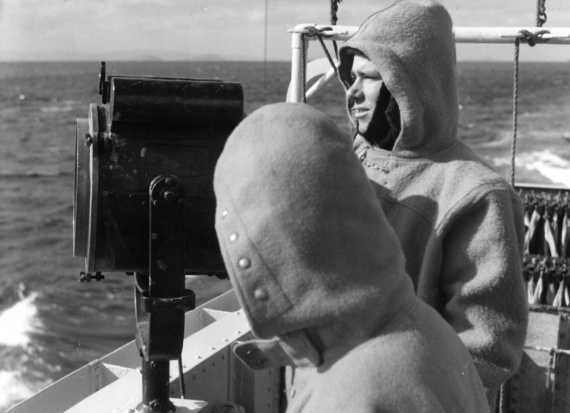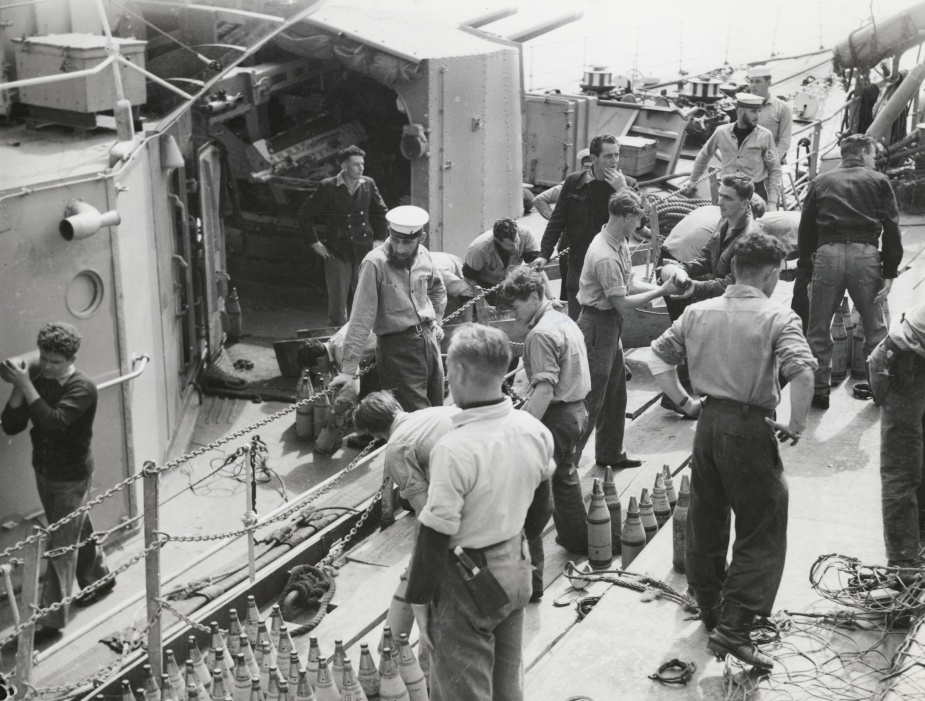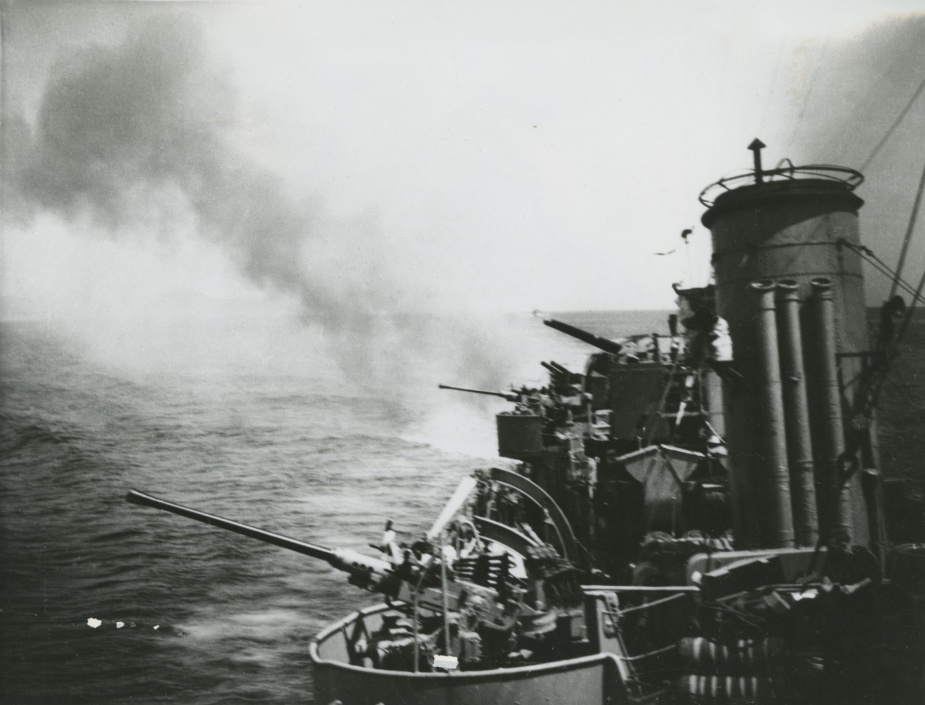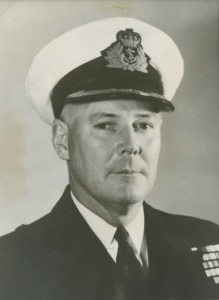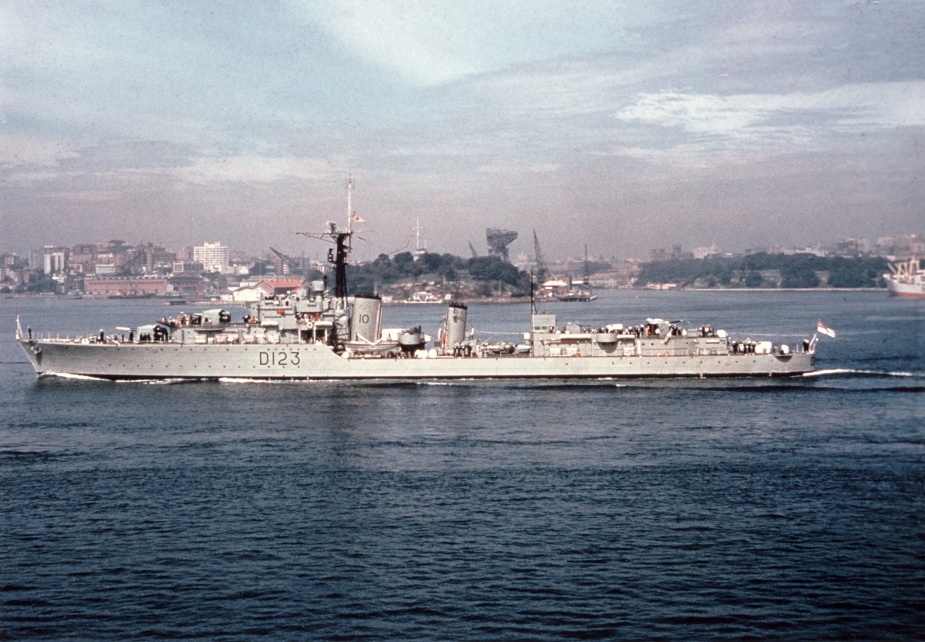HMAS Warramunga (I)
| Class |
Improved Tribal Class |
|---|---|
| Type |
Destroyer |
| Pennant |
I44 |
| Builder |
Cockatoo Docks and Engineering Co Ltd, Sydney |
| Laid Down |
10 February 1940 |
| Launched |
7 February 1942 |
| Launched by |
Mrs Forde, wife of the Minister for the Arm |
| Commissioned |
23 November 1942 |
| Decommissioned |
7 December 1959 |
| Dimensions & Displacement | |
| Displacement | 1970 tons |
| Length | 377 feet |
| Beam | 36 feet 6 inches |
| Draught | 9 feet |
| Armament | |
| Guns |
|
| Torpedoes | 4 x 21-inch torpedo tubes |
| Other Armament | Squid triple barrelled depth charge mortar |
| Awards | |
| Battle Honours | |
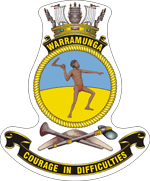
HMAS Warramunga was commissioned at Sydney on 23 November 1942 under the command of Commander Emile FV Dechaineux DSC RAN.
Warramunga completed final acceptance trials in December 1942 and on 30 December departed for Brisbane, where she was occupied for a month in working up trials. This was followed by a shakedown trip to Melbourne, which she reached on 1 February 1943.
Returning to Sydney on 6 February, Warramunga was ordered on 8 February to the scene of a torpedoing south of that port, but her search for the enemy submarine was unavailing. On 10 February the merchant ship Starr King was torpedoed east of Sydney, and on this occasion Warramunga picked up survivors, whom she took back to Sydney. Three days later Warramunga escorted USS Portland out of Sydney for part of the American cruiser's passage to New Caledonia before putting into Wellington for fuel, and then departing for Townsville. Portland was on her way back to the USA for repairs after having been severely damaged at Guadacanal the previous November.
The next few weeks were occupied in escorting convoys to both Townsville and Port Moresby, and on 19 April the ship arrived at Brisbane for refitting, with long leave granted at the same time. From early in May onwards, with the exception of a three day stay in Sydney, Warramunga was attached to Task Force 74, which consisted of the Australian Squadron (at that time HMA Ships Australia, Hobart and Arunta and a group of American cruisers and destroyers) and commenced a programme of exercises in the Dunk Island, Palm Island and Cid Harbour areas, returning to Townsville at odd intervals.
On 25 July 1943 the Task Force proceeded north inside the Great Barrier Reef to Princess Charlotte Bay. Two days later it sailed eastwards to the patrol area which had been allotted to it for the landing on Woodlark Island. On completion of this operation the Task Force departed for Milne Bay, arriving there on 31 July.
Warramunga continued to be based on Milne Bay during the first part of August, employed on anti-submarine patrols and guardship duties while in harbour. On 11 August she proceeded with Arunta to Woodlark Island with a group of Landing Ships Tanks (LSTs), which were then escorted by the two ships to Noumea. This six day voyage was uneventful and on 20 August Warramunga departed Noumea with Arunta at 27 knots to Espiritu Santo (New Hebrides) where the damaged Hobart had been temporarily repaired after being torpedoed south of the Solomons. The two destroyers escorted the cruiser to Sydney, arriving there on 26 August.
Warramunga remained in Sydney until 29 August storing, washing boilers and ammunitioning, and then sailed for Townsville, arriving on 31 August. After more exercises near Palm Island and two convoys to Milne Bay, she sailed for Melbourne, arriving on 17 September. From there she escorted a convoy as far as Lady Eliot Island, in company with USS Helm, and then another from Sydney to Lady Eliot Island. This last convoy was met again by the two ships at Grafton Passage and escorted to Goodenough Island. Both convoys carried units of the 1st and 2nd United States Marine Divisions. Having returned to Milne Bay from this duty, Warramunga sailed for Sydney for a boiler clean and refit, leaving there on 29 October with the newly arrived HMAS Shropshire for Brisbane, where the remainder of the Australian Squadron was lying.
On 2 November 1943 Warramunga, Arunta, Australia and Shropshire and Helm sailed for Milne Bay with Rear Admiral VAC Crutchley VC DSC RN in command. This force left Milne Bay on 11 November for a flying visit to the Solomons, returning on the 15th when DESRON 4 (4th Destroyer Squadron) was formed comprising USS Ralph Talbot, Helm, Arunta and Warramunga.
DESRON 4 bombarded shore installations at Gasmata, New Britain, on 29 November 1943, this being the first time the ship had been in action. This operation marked the beginning of the offensive sweep westwards along the New Guinea coast, and was followed by the Allied landing at Arawa, distant support being furnished by Task Force 74, of which DESRON 4 was a part.
On Christmas Eve 1943 Task Force 74 departed once more from Milne Bay, this time for Cape Gloucester, which was reached at first light on Boxing Day, and there took part in the bombardment which preceded the landing by United States troops. The enemy made no answering fire to the warships and the force withdrew to Buna. This was followed on 1 January 1944 with the landing at Saidor on the Huon Peninsula, and once again Warramunga took part with the other ships of DESRON 4, although this time she did not carry out any bombardment. Following one more convoy to Cape Gloucester, Warramunga detached from DESRON 4 and sailed for Sydney where she arrived on 11 January 1944.
On 4 February the ship departed Sydney for Milne Bay and Cape Sudest. In Milne Bay on 14 February she embarked the Chief of Naval Staff (Admiral Sir Guy Royle KCB CMG), other senior officers and Mr Essington Lewis, the Director General of Munitions Production. This party was taken to Cape Sudest, Langemak and Lae where it disembarked to continue its tour of the forward areas by air, and Warramunga returned to Cape Sudest.
Another convoy was taken to Cape Gloucester before Warramunga rejoined Task Force 74 in Milne Bay, remaining with the Force until 27 February. Between 29 February and 5 March she took part in operations covering the landing in the Admiralty Islands and on the latter date Captain Dechaineux left by air for Sydney to take command of HMAS Australia, being relieved by Commander N.A. Mackinnon RAN. From then until 26 March Warramunga was employed in convoy duties to the Admiralties and Saidor, with a brief maintenance period alongside USS Dobbin at Cape Sudest between 19 and 22 March.
From 26 March onwards she was once more with the Task Force. The period up until 14 April was spent at Milne Bay where the opportunity was taken of washing through the boilers and having another three day maintenance period. The Task Force sailed on 14 April 1944 for Seeadler Harbour, in the Admiralties, and on 19 April departed to rendezvous with the attack force for the forthcoming operations at Tanahmerah Bay, Humboldt Bay and Aitape.
Warramunga, with the other ships of Task Force 74, was assigned to the Tanahmerah Bay operation, and early in the morning of 22 April commenced the bombardment against previously specified objectives. The ships of the force remained in the vicinity of the landings for the next few days, carrying out patrols. They returned to Seeadler Harbour on 28 April and again on 3 May, the time in between being spent on uneventful patrols in the Humboldt Bay and Tanahmerah Bay areas. Task Forces 74 and 75 departed Seeadler on 15 May to act as cover for the forces landing in the Wakde - Sarmi area on 17 May, Warramunga again carrying out a bombardment.
The two Task Forces left the area on 21 May, and having replenished at Humboldt Bay took part in covering the attack force which was making towards Biak. On this occasion two American destroyers were fired on and hit by a concealed shore battery, and an enemy air attack took place during the bombardment, but Warramunga was not damaged. During May 1944 Warramunga completed her first 100,000 miles since commissioning.
Further patrol duties were undertaken by Warramunga working with the combined Task Forces in the Biak area, starting on 3 June. On 4 June, four enemy aircraft made a glide bombing attack, damage being inflicted on two of the American cruisers, but Warramunga was not hit. Next an unknown number of torpedo bombers made an abortive attack on the cruiser and destroyer force. On 6 June the ships returned to Humboldt Bay. On 9 June off Biak the ship took part in chasing five enemy destroyers. The enemy was engaged but no positive results were obtained and the enemy ships made their escape. The period until 29 June was spent in Humboldt Bay and Seeadler where Warramunga went alongside USS Dobbin for a boiler clean and refit, which was completed on 24 June. 29 June saw the combined Task Forces proceeding to sea again to participate in the landing on Noemfoor Island. Commodore John Collins CB RAN had assumed command of Task Force 74 on 13 June in succession to Rear Admiral Crutchley.
After this operation Warramunga and the other ships of the two Task Forces returned to Seeadler, moving to Aitape on 12 July 1944, from whence she departed with Australia to bombard Yakasui area, Warramunga having a Piper Cub as spotting aircraft. The next day Warramunga, Arunta, USS Bache, USS Ammen and two PT boats took part in an unsuccessful barge hunt.
On 17 July Australia bombarded Marubian, screened by Warramunga, and three nights later Warramunga and two PT boats made a successful sweep along the coast from Marubian to Karawop, engaging several barges and shooting up truck traffic. While returning, the ship met Australia, Shropshire and Arunta and acted as screening ship for Shropshire during a bombardment, after which all ships returned to Aitape.
Warramunga and Warramunga departed for Sydney on 22 July with Commander Task Force 74 shifting his flag to Shropshire. Almost the whole of August was spent in Sydney for refit and long leave. The ships of Task Forces 74 and 75 which had been in Sydney for rehabilitation - US Ships Phoenix, Hutchins, Daly, Beale, Bache, Abner, Head, Mullany, Ammen, Boise, with Arunta and Warramunga arrived in Milne Bay on 30 August and after fuelling arrived in Seeadler on 1 September.
On the 10th, with the addition of Australia, Shropshire and USS Nashville and USS Bush, they sailed for Humboldt Bay and Morotai where a landing was to take place on 15 September. In this operation Warramunga did not bombard, her efforts confined to sinking a Japanese barge on the way in. The operation completed, the Task Forces patrolled for two days, and then sailed for Manus via Mios Woendi, remaining there until 11 October when all ships sailed for Humboldt Bay. At Manus on 30 September, Commander Mackinnon became ill and was admitted to the USN hospital there, being relieved by Lieutenant Commander JM Alliston DSC RN, from Shropshire.
On 13 October 1944 Warramunga sailed from Hollandia as a unit of the vast armada assembled for the American landings at Leyte Gulf in the Philippines. She was attached with Australia, Shropshire and Arunta to Task Group 77.3 (Close Cover Group) under Rear Admiral Berkey USN. The pre-landing bombardment began on the morning of 20 October 1944, fire being opened by the American battleships West Virginia, Maryland and Mississippi followed by the cruisers Boise, Phoenix, Australia and Shropshire, with the destroyers in support.
Following the landings and throughout the day, Warramunga gave fire support in response to calls from the shore and as suitable targets presented themselves. The next day, 21 October, she sailed from Leyte escorting the USS Honolulu and Australia, both ships having been damage during Japanese kamikaze (suicide) air attacks. After escorting the ships to Palau and Australia to Manus, Warramunga returned to Leyte escorting a convoy from Hollandia via Biak and Palau. Arriving in Leyte Gulf on 12 November 1944 she joined Task Group 77.1 which included battleships, heavy and light cruisers and destroyers. This group was not attacked by the enemy up to the time of Warramunga's departure on 25 November, although fire was opened on two occasions at enemy aircraft at long range, the Japanese air effort at this time being directed against merchant ships and small craft, suicide tactics being frequently used.
On 22 November a Catalina aircraft was seen to crash on Samar Island, 20 miles away, and Warramunga obtained permission to leave her radar picket patrol to investigate. The First Lieutenant and the doctor landed with a heavily armed whaler's crew, but in view of the fact that according to the local villagers there was a large Japanese force not far away it was considered prudent to withdraw the search party before dark. Warramunga turned over the details of the incident to a high speed air-sea rescue craft which she intercepted, and resumed her patrol.
After sailing from Leyte on 25 November it was discovered that one of the able seamen was missing, but on arriving at Manus it was found that by great good fortune he had been picked up by USS Mugford. The ship remained at Manus until 26 December 1944 when she sailed for Kossol as a unit of Task Group 74.1.
In January 1945 Warramunga took part in the second phase of the Philippines campaign, the landings at Lingayen. The entire attack force for the operation comprised in all 850 ships of which 305 were fighting or semi-fighting ships. Eleven RAN ships were included, four of them Australia, Shropshire, Arunta and Warramunga attached to Task Group 77.2 consisting of six battleships, six cruisers and twenty-nine destroyers. The landings were successfully completed on 9 January in the face of continual air attack. Twelve ships of Task Group 77.2 were damaged by kamikaze planes, including Australia which was hit five times and severely damaged.
From 6 to 18 January Warramunga was operating off Lingayen Gulf in company with Task Group 77.2 and the escort carriers. On the 6th she was singled out for attack by enemy aircraft while giving support to the minesweepers, and later on that day was about to be attacked by a suicide plane when it sheered off and crashed into USS Brooks, another at the same time hitting USS Humphries. Both ships caught on fire and Warramunga went to the assistance of Brooks, extinguishing two fires, one of which menaced the magazine, and taking wounded aboard. She then took Brooks in tow passing on the way northward the heavy ships of the Task Group on the opposite course, one of which shot down another suicide plane as she passed. Having escorted Brooks (now being towed by HMAS Gascoyne as the previous tow had parted) to shoal water off Santiago Island, Warramunga returned to the southern end of the Gulf to transfer the remainder of Brooks personnel to USS Pennsylvania. This proved to be a most difficult task, as it had to be done by motorboat, with the battleship underway the whole time and bombarding and altering course frequently.
On 9 January Warramunga carried out a bombardment in further support of the landing, engaging two enemy aircraft while taking up position. The following day, intercepted signals indicated that suicide swimmers and enemy motorboats were active among the transports and Warramunga carried out a patrol to the northwards of the transport area.
On 18 January 1945 Allied shore based fighters had begun to operate from captured landing fields, and the Task Group anchored at the southern end of the Gulf. West Virginia bom bombardment Japanese positions on the eastern side on 22 January screened by Warramunga and USS Izard.
A Japanese surface force was detected moving up the Saigon coast, and on 12 February Warramunga and Arunta left Lingayen at 25 knots and commenced trailing it, their mission being to await distress calls from aircraft employed on striking the enemy ships. At one time the two destroyers were within 220 miles of Hong Kong.
On 15 February 1945 Warramunga and Arunta fuelled in Lingayen Gulf and joined a cruiser and destroyer force which was to bombard Corregidor. In this operation, immediately on completion of the naval shelling and usual heavy bombing attack, paratroopers were dropped on the island from Douglas transport aircraft. The warships, however, by this time were fully occupied in avoiding floating mines, of which thirty were sighted and destroyed by ships of the screen and the minesweepers.
Warramunga's next operation was the attack on 26 March on Cebu City, in company with the newly arrived Hobart. The time in between these last two operations had been spent in Leyte and Manus, and on the satisfactory completion of the attack the two Australian ships left for Subic Bay, where they arrived 30 March. Most of April was spent in Subic Bay. Task Force 74 sortied on 8 April to investigate a reported enemy surface force north of Luzon, but the report proved false and the force returned to harbour on the same day.
On 18 April Commander MJ Clark DSC RAN assumed command of Warramunga. Her next operation was in support of the AIF landing at Tarakan, which took place on 1 May 1945. On the way from Subic Bay to Tarakan some of the numerous canoes which were sighted proved to have Japanese on board. Several of these were captured, the others either blowing themselves up on being approached or being shelled while making their escape. For the four days before the actual landing support was given to the minesweeping and hydrographic groups by the cruisers and destroyers of Task Group 74.3. Warramunga and the other destroyers of the group carried out a bombardment on 30 April and while she was withdrawing through the channel south of Menulum with USS Jenkins, the latter ship was mined. When the assault troops had landed next day, Warramunga gave fire support after first firing on the suspected launching site of torpedoes which were reported among the ships of the convoy. Hobart and Warramunga then sailed for Morotai and Hollandia.
On 10 May Warramunga, Hobart, Arunta and HMS Newfoundland (the Wewak Support Force) arrived off Wewak and bombarded shore positions. The next day they were joined by HMA Ships Swan, Colac and Dubbo. All ships gave fire support for the assault. After the landing the ships stood off waiting to give further support if required, but this was not necessary and they sailed on the 12th for Hollandia. The following day Warramunga departed for Sydney via Milne Bay for refit, which was completed in early July 1945. She departed Sydney on 9 July for Subic Bay with Commodore Collins (Commodore Commanding Australian Squadron) on board, and was in Subic Bay when Japan's acceptance of the peace terms was announced.
On 18 August 1945 Warramunga sailed from Subic Bay for Manila arriving the next day. On the 25 August she sailed for Tokyo Bay, where she arrived on 31 August. On 4 September Warramunga transferred General Gardiner and the Commander-in-Chief, British Pacific Fleet (Admiral Sir Bruce Fraser) from HMS Duke of York to the Customs House Pier at Yokohama. The next and most pressing task was the recovery of Allied prisoners of war and internees.
On 6 September she departed in company with HMS Wizard for Hamamatau, where she joined the other ships of Task Unit 30.6.1, US Ships San Juan, Rescue, Nicholas, Taylor, Runels and Gosselin, HMS Tenacious and HMAS Bataan. The object of the operation was the removal of prisoners of war from camps in the vicinity of Nagoya, and after 'processing' them in a hospital ship (Rescue), took them to Yokohama for onward passage. Warramunga carried 174 repatriates to that port at 27 knots, the trip being uneventful except for the sighting of a floating mine within fifty yards of the ship. The prisoners of war consisted of British and American Army and Navy personnel, a few Dutchmen and one Australian. They had been captured at Singapore, Guam and Java.
On 10 September Task Unit 30.6.2, comprising US Ships Garrard, Rescue, Nicholas, Taylor, Gosselin and Runels, HM Ships Wizard and Wakeful, Bataan and Warramunga, left Tokyo Bay for Sendai on another recovery mission. The minesweepers were occupied in sweeping to the north as the Task Unit approached Shiogama, the port of Sendai, and its entry into the harbour was marked with an explosion every few minutes. On arrival contact teams were landed and by the afternoon all the internees from Fukushima internment camp were being dealt with in Rescue. 179, including some women and children, were embarked in Warramunga for passage to Yokohama. Most of these internees had been passengers in the Nankin and after that ship's interception by a German raider had been transferred to the Regensberg and then to the Dresden, a merchant ship bound for Japan. They comprised English, Canadian, Australian, African natives, Indians, Malayans, Greeks, Arabs, Javanese, a New Zealander, an American, a Spaniard and an Armenian. All of them were taken to Yokohama.
Warramunga departed Tokyo Bay on 13 September with mails and stores for the Task Group at Sendai, and from there proceeded in company with San Juan and Rescue, two floating docks and four landing craft for Kamaishi, arriving on the 15. Rescue teams were again landed and the group sailed the following day for Tokyo Bay with more ex prisoners of war. Having completed the evacuation of all prisoners of war from Northern Hohshu, Task Group 30.6 was dissolved on 19 September and Bataan and Warramunga rejoined Task Group 70.9. On 22 September the ship departed Tokyo Bay for Sydney, via Manus, arriving on 3 October 1945.
Post World War II history
In the post war period, Warramunga spent some five months of 1946 as the Australian Squadron representative in Japanese waters, returning to Australia at the close of June 1946 for refit. In January 1947, under the command of Commander GC Oldham, DSC, RAN, she returned to Japan as Squadron representative and remained in Japanese waters until April when she once more returned to Sydney.
The next few months were spent in home waters except for a visit to New Guinea, the Solomons and New Caledonia in September 1947. In November, in company with Arunta, she returned to Japan for her third post war Far East tour of duty. She returned to Sydney in April 1948. The remainder of 1948 followed the previous years pattern of service. After six months service in home waters, Warramunga proceeded to Japan for four months overseas duty, returning to Australia in March 1949. She spent the remainder of the year and the first seven months of 1950 on the Australia Station, except for a visit to New Zealand in March 1950.
In June 1950 hostilities commenced in Korea and on 6 August Warramunga sailed from Sydney to join United Nations forces in the Korean theatre. Warramunga began Korean War operations on 25 August 1950 when she departed Hong Kong escorting HM Ships Ceylon and Unicorn to Pusan.
On 3 September she began her first operational patrol of the war screening the carrier HMS Triumph on operations on the west coast. The Task Element (95.11) performed the usual pattern of carrier operations in the western sector; air strikes, spotting and reconnaissance by the carrier and bombardments by the cruiser and destroyer elements. The initial patrol ended on 9 September and was repeated with Warramunga (Senior Officer) and HM ships Charity, Cockade and Concord as Triumph’s screen between 12 and 21 September. Triumph and her screen were, during this period, one of the Task Units in the large naval force assembled off the west coast for the amphibious operations ending with the recapture of Inchon on 15 September.
A brief visit to Sasebo ended on 28 September when Warramunga embarked the Flag Officer 2nd-in-Command Far Eastern Fleet (Rear Admiral WG Andrewes CB CBE DSO RN) for Inchon. There Commander 7th Fleet (Vice Admiral AD Struble USN) came on board for a brief conference prior to taking part in the official turnover of Seoul to the South Korean civil administration.
This duty completed Warramunga proceeded to the Kunsan area and, joining Bataan, carried out patrols and bombardments until 4 October, enforcing the blockade and harassing the withdrawing North Korean forces. On 8 October Warramunga reported for duty at Sasebo to CTG 95 (Vice Admiral VA Smith USN) in USS Worcester and was assigned as part of the British forces scheduled to join the main body of United States forces for the landings at Wonsan on the east coast. Warramunga duly played her role in these large scale operations, operating under Rear Admiral Hartman USN in USS Helena.
Warramunga spent 12 and 13 October screening the battleship USS Missouri and from 13 to 20 October operated with Hartman’s force TG 95.2. The remainder of the month was spent on courier duties to the carriers at sea and as control ship at Wonsan. The landings planned as an assault changed to a routine disembarkation when South Korean troops captured the town before the planned date.
November was a quiet month with nothing more exciting than the escort of an American dredger en route for Chinnampo. On the last day of the month Warramunga Joined the Canadian ships Cayuga, Athabaskan and Sioux on patrol off the north west corner of the Korean mainland, the Yalu Gulf, with orders to enforce a strict blockade.
In early December Warramunga took part in the evacuation of United Nations forces from Chinnampo, followed by a period on the screen of the west coast carrier element HMS Theseus. On 10 December the destroyer returned to the Yalu Gulf for patrol duties interspersed with operations as a unit of the Inchon Support Element. Christmas Day was spent at Inchon with heavy snow falling and extremely low temperatures. It was a busy month with many excursions and alarms in a period of withdrawal for the United Nations forces. At the close of the year Warramunga completed her fifth week away from her base.
The first days of 1951 found Warramunga still at Inchon assisting in the evacuation of United Nations troops. The deployment was completed on 4 January and by the following day the naval gun fire support ships (USS Rochester, HMS Ceylon and Warramunga) were the only vessels left in the area. There they remained maintaining harassing fire until 9 January when the group was disbanded and Warramunga left for Kure for a half yearly docking. The ship had spent 45 days out from Sasebo either on patrol, screening or naval gun fire support.
Warramunga returned to operational duty on 3 February when she joined an American destroyer group (95.2), led by USS English, on the east coast off Kangnung. Coastal harassing fire was begun the same day, followed by two days screening USS Manchester and the battleship Missouri. Late on 5 February Warramunga and USS Lind detached and proceeded north to 38° 05' on the coast where Lind had previously landed an intelligence party. This party had been captured by the North Koreans who, using the team’s equipment, arranged a rendezvous with Lind. Unbeknown to the enemy, their deception was discovered and the two destroyers planned an unpleasant surprise. Right on time the enemy showed the prearranged signal.
Warramunga’s commander commented ‘USS Lind asked me if light was bright enough for an aiming mark and I replied it could be brighter. The enemy obliged by turning up to full brilliancy. We then opened up as fast as we could fire. I expended 59 rounds 4.7 inch and Lind about the same amount. The light went out. Subsequent intelligence confirmed that one North Korean company, some North Korean police and a large Intelligence team who were assembled as a reception committee were mostly killed or wounded. As the range was less than 3000 yards and the fire was extremely rapid the result was not surprising.’
Proceeding north the two destroyers bombarded a number of points on the coast before rejoining the screen of Missouri for a few hours on 7 February before the battleship left the area. The remaining ships of the bombardment group remained on the coast maintaining harassing fire until 12 February when, after Manchester had completed a shelling on Tanghon, the force withdrew to the south for Sasebo.
Two further east coast operations were carried out by Warramunga in February, with two days spent bombarding the Wonsan area with HMS Belfast and Lind in company, followed by relief of USS Borie for naval gun fire support off Kangnung. The close of February found Warramunga still harassing the enemy ashore on the mainland. Only five days of the month had been spent out of the operational areas and more than 1,000 rounds of 4.7 inch ammunition had been fired in anger, and nearly 5,000 miles steamed. The patrol ended on 4 March when Warramunga passed her duties to Borie.
Gale inflicted damage to Warramunga brought about a period of enforced idleness in March and April delaying her return to the west coast until 11 April when she relieved HMS Black Swan as CTE 95.12 (Warramunga, Amethyst and Nootka) and Senior Officer West Coast Blockade.
The first period of the patrol (11 to 16 April) consisted of organising patrolling of small units (Republic of Korea) on the coast and gaining intelligence for CTE 95.15 (Belfast) during operation in the Yalu Gulf. On 17 April Warramunga turned over command of TE 95.12 to Belfast and proceeded to the Haeju area to assume control of Korean minesweepers. Supervision of the sweeping operations continued for two days when Warramunga joined HMS Comus for mine search, patrol and bombardment duties. The patrol ended on 21 April with operations off the Inchon approaches.
Screening of one of the west coast carrier elements (HMS Glory) began on 26 April with Warramunga as Senior Officer. HMAS Bataan joined on 29 April followed by US Ships Richard B. Anderson and Perkins on 2 May. The patrol for Warramunga ended on 4 May after a period of perfect flying conditions for Glory.
In mid May 1951 Warramunga arrived at Yokosuka to begin a period of exercises with the submarine USS Redfish before joining the screen of the carrier USS Bataan for further west coast operations. Bataan’s last patrol ended on 4 June when the carrier and screen arrived off Sasebo, where Warramunga remained until 12 June when she left to begin operations on the screen of Bataan’s replacement, USS Sicily.
In July 1951 Warramunga spent 23 days on west coast patrol screening Sicily with her mixed escort of American, Dutch, Australian and Canadian ships. The weather was perfect and flying constant, though for the destroyers the task was routine. A record mileage of 8,625.6 was logged by Warramunga, being the highest monthly total steamed by the ship since commissioning in 1942.
On 2 August 1951 Warramunga sailed from Sasebo to begin her last patrol. After acting as postman to a number of ships in the Inchon area she joined the blockading group (TE 95.12), with the Senior Officer in Ceylon, at Haeju and was ordered to begin bombardment from as close inshore as possible. On the evening of 4 August Warramunga began shelling enemy shore positions after a lapse of several weeks. The following day spotter planes from Sicily assisted with, according to the American pilots, highly gratifying results.
On 6 August Warramunga temporarily detached from TE 95.12 and proceeded north to the Yalu Gulf to carry out surveillance in an attempt to estimate enemy activity. Finally on 7 August, back at Haeju, she fired a final bombardment of 110 rounds as a parting gesture, bringing a years operational service to a close. Warramunga returned to Sydney on 6 September 1951 after an absence of 13 months on Korean War service.
Following a refit working up period she sailed on 11 January 1952 for her second tour of Korean War service. She departed Fremantle on 17 January, escorting the carrier HMS Glory, also en route to Korea, and arrived in Sasebo on 5 February. The following day she commenced her first patrol screening Glory off the west coast of Korea.
On 7 February Warramunga detached and joined the nightly patrol in the Paedongyong-Do area. Early the following morning intelligence informed her Commanding Officer that Mahapto Island had been invaded from the mainland and its guerilla forces evacuated. Joined by the American rocket ship LSM(R) 401 and a Korean patrol craft the destroyer heavily bombarded the newly taken position. Later the same day Warramunga rejoined the screening forces protecting Glory. On 10 February she detached once more for island patrol, as her Commanding Officer commented ‘to trail my coat along the coast.’ Refuelling at Taechong-Do on the 11th, Warramunga met her sister ship HMAS Bataan, also on the first patrol of her second tour. After a further brief spell with Glory she detached for Kure on 16 February.
On 25 February Warramunga crossed the 38th parallel on the east coast of Korea north bound to report to CTG 95.8 at Wonsan, who ordered her to relieve HMNZS Taupo at Songjin. The following two days, in extreme cold and heavy snow, she bombarded Songjin, Yangdo and coastal railway communications. The month closed with Warramunga and USS Doyle maintaining the nightly patrol to 41° 50' north and harassing Chongjin by day.
In the first days of March 1952 Warramunga continued to operate as one of the units blockading and bombarding the north east coast and defending Yangdo. On 2 March, closing to 5,000 yards north of Chongjin, she was straddled by a salvo from a well hidden battery of five guns and in the ensuing running engagement successfully silenced three of them before the widening range stopped further gun play. Joined by Doyle the site was again shelled before both ships retired.
On 6 March CTF 95 (Rear Admiral George C Dyer USN) arrived in the area flying his flag in USS Samuel N. Moore. Concerned that an attempted landing by North Koreans on Yangdo on 20 February had come within an ace of succeeding, he ordered a tightening of the patrol and expressed his view that too many roofs were intact in Songjin and Chongjin in spite of the fact that both towns had been bombarded almost daily for a year. The resultant bombardment may or may not have satisfied Admiral Dyer but it was certainly thorough, although as Warramunga’s commander commented on the shelling of Songjin, ‘after an hour during which time we fired over 300 rounds, not much impression had been made in the appearance of the port. I do not think much work goes on in Songjin.’
After a fortnight of strenuous patrol on the east coast, Warramunga was relieved by HMS Morecambe Bay. On 8 March the Australian destroyer reached Wonsan and there embarked Admiral Dyer for Sasebo. ‘I was rather surprised’ commented the Commanding Officer, ‘after the events of past days, that he let me pass the bombline without a go at the enemy's front line.’
Warramunga began her third patrol screening Glory on the west coast on 13 March. On 17 March, with the destroyer in attendance, the carrier set up a record for a light carrier with 105 sorties. The patrol ended in gales and rain on 22 March when Glory and her screen called it a day and sailed south for Sasebo.
April brought another ten days operations on the screen of Glory interspersed with night coastal patrols, followed by a trip to Hong Kong for gun mounting repairs. On 10 May Warramunga returned to operations with her second east coast patrol, where according to all reports conditions remained lively. The day before USS James C Owens had suffered ten hits from an unrepentant Songjin battery. En route to Wonsan Warramunga bombarded three reported gun positions. She reached Songjin on 11 May and relieved Amethyst. US Ships Owens, Doyle and Evansville made up the remainder of the Task Element. The patrol proved as arduous as ever and there was little respite from the continuous harassing of the enemy.
On 17 May 1952 a change of venue came for Warramunga when she relieved USS Thomas at Chongjin covering the operating sweepers. That day 222 rounds of 4.7 inch ammunition were fired by Warramunga on battery positions located by spotting planes of Task Force 77. Operating between Chongjin and Songjin and constantly on the move, Warramunga continued to maintain a high rate of harassing fire, attacking enemy rail communications and covering the minesweepers. On 24 May her commanding officer Captain JM Ramsay, RAN, reported that he had ‘cleaned out Mount Katmai's 1,250 rounds of 4.7 inch.’
On 25 May Warramunga joined the American battleship USS Iowa and her attendant destroyers for a bombardment of Chongjin. From dawn to late afternoon Iowa kept an almost continuous 16 inch bombardment of the docks and factory areas while the destroyers maintained gun fire suppression shelling on suspected emplacements. Air strikes from the planes of USS Boxer and USS Philippine Sea added their quota of explosives during four brief lulls. It was Warramunga’s first participation in mayor bombardment operations although in November 1950 she had escorted Missouri to Chongjin for a similar assault. Her Commanding Officer records something of an anti-climax when she returned to Chongjin the following day with the destroyer USS Endicott ‘to drop a mere token ration on their doorstep.’
On 27 May Warramunga arrived off Chongjin from Songjin for the 11th consecutive and final day, ‘marking my last visiting cards ppc and dropping them on inland railway tracks.’ The following day she handed her patrol over to HMCS Nootka and after farewelling Endicott with whom she had operated on her two east coast patrols, she departed for Sasebo. More than 4,000 rounds had been fired from her main armament, exceeding 3000 during the two east coast patrols and the balance over a much longer period on the west coast.
Warramunga, after spending 10 to 18 June 1952 screening USS Bataan on the west coast, joined TU 95.12.1 in defence of the islands of Sokto and Choda on 29 June. The days that followed were uneventful and routine relieved only by a ‘set piece bombardment on American Independence Day.’ On 9 July HMCS Crusader relieved the Australian destroyer.
On 12 July Warramunga began her last patrol of the Korean War, screening USS Bataan. It was uneventful, distinguished for her crew only by the issue of free ice cream from the American carrier. On 21 July, after farewelling HMAS Bataan, also on the screen, she proceeded south with the carrier. On 26 July she sailed from Kure for Australia. Thus ended six months war operations during which the ship had spent some 3000 hours underway since leaving Australia, steamed 40,000 miles and fired 4,151 rounds from her main armament.
Warramunga returned to Sydney on 12 August 1952 and went into dockyard hands for modernisation as an Anti-Submarine Destroyer. She paid off on 12 November 1952 having steamed 400,226 miles since commissioning on 23 November 1942.
Warramunga recommissioned on 19 October 1954 but remained under dockyard control completing a modernisation programme until February 1955. As converted, her main armament consisted of four 4.7 inch guns of an improved type and two 4 inch guns. A ‘Squid’ triple barrelled depth charge mortar was also fitted. Her original main armament consisted of six 4.7 inch and two 4 inch guns.
On 17 May 1955 Warramunga departed Sydney as a unit of a combined RAN and RNZN force for the Far East for a series of fleet exercises with units of the Royal Navy. These exercises were completed at the close of June and on 2 and 3 July the Australian destroyers Anzac and Tobruk and the frigate HMAS Quadrant sailed from Singapore to return to Australia. Warramunga and her sister ship Arunta, however, remained on Far East service ‘as the first Australian ships of the Strategic Reserve.’ This service came to an end at the close of November 1955 when Warramunga's Captain commented that the ship had gained 'most interesting and valuable experience' ranging from the combined RAN, RN and RNZN exercises in June to anti-submarine exercises with the United States Navy in July/August and a Fleet Regatta in November. ‘Visits to Bangkok, Okinawa, Japan, Hong Kong and to ports on the east and west coasts of the Malay Federation were enjoyed by all.’
Warramunga returned to Sydney on 19 December after an absence of 215 days on Far East service. During 1956 and 1957 Warramunga’s service was mainly confined to home waters except for a visit to New Zealand in September 1956 and a return to the Far East in April 1957 to take part in joint exercises with forces of the South East Asia Treaty Organisation (SEATO).
In January 1958 Warramunga proceeded for her second tour of duty as a unit of the Far East Strategic Reserve. During the SEATO exercise OCEAN LINK in May 1958 she steamed her 500,000th mile since her first commissioning in 1942. In steaming half a million miles the ship had been 35,527 hours underway. She returned to Sydney on 3 September 1958.
The remainder of Warramunga’s seagoing service was confined to Australian waters. In 1959 it was decided to pay off ‘Little Mo’ as she was nicknamed. On 5 November 1959 she sailed from Melbourne for Sydney, where she paid off on 7 December. It proved to be her last voyage as a commissioned warship. After 18 months in reserve she was declared for disposal on 22 May 1961. On 15 February 1963 she was sold to the Japanese firm Kinoshita & Co Ltd for breaking up and subsequently left Sydney under tow for Japan.
Further reading
'The Warramunga Story' by HMAS Warramunga Veterans' Association of Australia.



